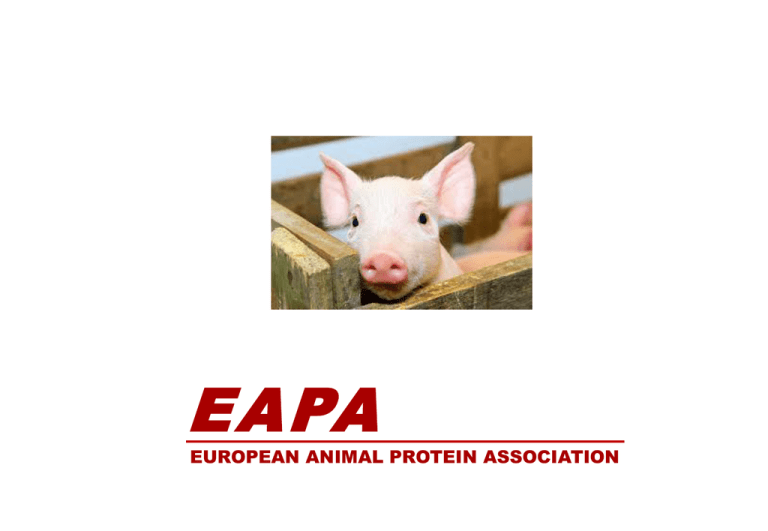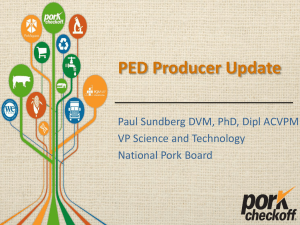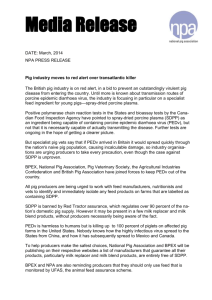Presentación de PowerPoint
advertisement

EAPA EUROPEAN ANIMAL PROTEIN ASSOCIATION Seminar “PEDv and how piglets can benefit from Plasma” Chairman: Henk Flipsen, MSc - Director of NEVEDI, the Dutch Feed Compounder Organisation 14.00 Reception with coffee and tea 14.30 Opening by the president of EAPA: Mr. Albert Gibert 14.35 Background of the PED virus by Dr. Tanja Opriessnig - Associate Professor, Iowa State University, USA and Professor, The Roslin Institute, UK 15.15 Spray drying techniques by Dr. Martijn Fox – Project Manager Processing, NIZO food research, NL and design of a risk assessment by Dr. Lourens Heres – Veterinary Epidemiologist, VION Food, NL 15.45 Coffee break 16.00 Research Overview by Dr. Javier Polo – Vice president Research & Development, APC, Spain 16.30 Plasma as a healthy ingredient in piglet feed by Dr. Jos Houdijk – Senior researcher Animal Nutrition and Health, SRUC, UK E A PA EUROPEAN ANIMAL PROTEIN ASSOCIATION 2 17.00 Round Table Discussion Led by: Henk Flipsen Participants: Dr. Tanja Opriessnig, IOWA State University – The Roslin Institute; Dr. Martijn Fox, NIZO; Dr. Marcel Hulst – Molecular Virologist, Wageningen UR, NL; Dr. Lourens Heres, VION Food Dr. Javier Polo, APC Dr. Jos Houdijk, SRUC 17.45 Wrap up of the Round Table discussion by Henk Flipsen 17.50 Final word of the president of EAPA: the take home message of today 17.55 Networking accompanied by a drink and a snack Approx. 18.30 h. closing of the seminar *NOTE: All presentations will be presented to you after the seminar via the EAPA website E A PA EUROPEAN ANIMAL PROTEIN ASSOCIATION 3 Henk Flipsen – Chairman seminar MSc - Managing director of the Dutch Feed Industry Association (Nevedi) Age 49 Married, 4 children Nevedi members represent 95% of the sector and produce appr. 13,5 million tons of compound feed. The yearly turn over is 4,5 billion euro in the Netherlands and offers employment to 6000 persons. Vice president of Product Board Animal Feed and board member of the European Federation for the Feed Industry (Fefac). E A PA EUROPEAN ANIMAL PROTEIN ASSOCIATION 4 Tanja Opriessnig Mag. med. vet., Dr. med. vet., Ph.D. Chair of Infectious Disease Pathology, The Roslin Institute, University of Edinburgh, UK Professor, Veterinary Diagnostic and Production Animal Medicine, Iowa State University, Ames, Iowa, USA Prof. Tanja Opriessnig completed her veterinary degree at the University of Veterinary Medicine in Vienna, Austria in 2000. In 2002, she received her advanced degree in Veterinary Science from the same University. From 2002 to 2006, Prof. Opriessnig worked as a postdoctoral researcher at Iowa State University and she completed a Ph.D. in Veterinary Pathology. From 2006 to 2013, she worked as Veterinary Diagnostic Pathologist at the Assistant or Associate Professor rank in the Veterinary Diagnostic Laboratory at Iowa State University. Since 2013 Prof. Opriessnig has a joint appointment with the Roslin Institute, University of Edinburgh and the Department of Veterinary Diagnostic and Production Animal Medicine, Iowa State University. Her current research focus is on pathogenesis, control, and diagnosis of infectious pathogens in pigs with emphasis on porcine circovirus type 2, porcine reproductive and respiratory syndrome virus, Erysipelothrix rhusiopathiae, porcine parvovirus, porcine astrovirus, porcine epidemic diarrhea virus, and swine hepatitis E virus. Since 2002, Prof. Opriessnig published > 150 peer-reviewed manuscripts in various journals of virology, microbiology and veterinary relevance. E A PA EUROPEAN ANIMAL PROTEIN ASSOCIATION 5 Background on porcine epidemic diarrhea virus (PEDV) and other emerging coronaviruses in pigs By Dr. Tanja Opriessnig – 14.35 - 15.15 Porcine epidemic diarrhea virus (PEDV), an Alphacoronavirus, is a member of the Coronaviridae family which is a group of single-stranded, positive-sense RNA viruses. Outbreaks of PEDV have occurred in swine producing areas in Europe since 1971 and were introduced to Asia in the early 1990’s. Most PEDV strains circulating in Europe and Asia prior to 2010 belong to genogroup 1. In recent years, large-scale outbreaks with high rates of morbidity and mortality have been observed in China, Korea, and Thailand. These recent outbreaks have been associated with novel, genetically distinct PEDV isolates (classified as genogroup 2 PEDV). Clinical signs in affected herds are characterized by acute vomiting, anorexia, and watery diarrhea in pigs of all ages, with up to 90-95% mortality in suckling pigs for a 4-5 week period of time in naïve breeding herds. PEDV emerged in North America in April 2013 and has spread rapidly through the pig population to 29 states in the US, Canada and Mexico as of May 2014. PEDV has now also been reported in South America. With the rapid spread of PEDV in North America, questions and concerns over possible routes of PEDV exposure were raised. Some countries (UK) and regions and certain pork production companies made the decision to ban the use of spray-dried porcine plasma in pig diets as a precaution to decrease the risk of introduction. A major problem with PEDV is that effective vaccines for PEDV are still not available. Recently, another member of the Coronaviridae family, porcine delta coronavirus (PDCoV) was discovered initially in Hong Kong and later in the US. The clinical importance of PDCoV is currently unknown. Current knowledge on both PEDV and PDCoV will be discussed. E A PA EUROPEAN ANIMAL PROTEIN ASSOCIATION 6 Martijn Fox Project manager Processing & safety at NIZO food research Martijn Fox works as a project manager at the department of Processing & safety of NIZO food research since 2006. Before joining NIZO, he did a PhD at Wageningen University on the interface of food and microtechnology/microfluidics. At NIZO, Martijn is mainly involved in projects on evaporation and spray drying. These projects often involve troubleshooting, optimization and cleaning (CIP) of process lines, where the effect of the process on product properties is of key interest. Next to the practical projects, more fundamental, collaborative projects with universities are executed, like the micro spray drying project, where a single droplet drying analysis method was developed to study inactivation of probiotics. In addition, Martijn is the course leader for the annual drying and evaporation course that NIZO organizes for the worldwide industry. E A PA EUROPEAN ANIMAL PROTEIN ASSOCIATION 7 Spray drying techniques By Martijn Fox – 15.15 – 15.45 Spray drying is a process where a fluid product is atomized to small droplets which are subsequently dried in hot air. Spray dryers are complex equipment with many different parameters which can be adjusted, such as the inlet and outlet air temperature, the feed flow, the dry solids content of the feed, droplet distribution during atomization, etc. In addition, many different configurations are possible; single stage dryers, which only consist of a drying chamber, twostage dryers, which have a fluidized bed after the drying chamber to dry the product to a further extent and to cool it and multistage (MSD)-dryers, which also include an internal bed for enhanced agglomeration and capacity. All these factors will influence the capacity and energy consumption to a large extent. More important, however, these differences will also influence the final product properties since the droplet will experience a specific heat load and drying profile. Examples of these product properties are the bulk density, (in)solubility and survival/inactivation of biological components. In this presentation, an introduction to spray drying will be given, which highlight the most important parameters of the spray drying process. Subsequently, several examples will be shown from research that has been done on the survival of Lactobacillus plantarum WCFS1. This research has been performed at a single droplet level, but was validated up to pilot scale spray drying equipment. E A PA EUROPEAN ANIMAL PROTEIN ASSOCIATION 8 Lourens Heres Veterinary Epidemiologist at VION Food Dr Lourens Heres is a veterinary expert in public health and epidemiology. After his graduation as veterinarian in 1999 the subject of his PhD was Salmonella and Campylobacter control in poultry with feeding interventions. He subsequently worked an additional 5 years as researcher at the Dutch Central Veterinary Institute, where he was responsible for project on the epidemiology and risk assessments of BSE in ruminants. Since 2007 he is Manager R&D – Food Safety at VION Food Group. He runs projects on risk based approaches for the surveillance and control of microbiological and chemical contaminants in food supply chains, modernisation of official supervision, and quality assurance. In his fields of expertise he published more than 20 papers in peer-reviewed scientific journals. E A PA EUROPEAN ANIMAL PROTEIN ASSOCIATION 9 The principles and building stones for a (semi-) quantitative microbiological risk assessment to understand the virus safety of spray dried plasma for animal feed. By Lourens Heres – 15.15 – 15.45 The biggest merrit of this risk assessment project is the structured description of virus reduction and exposure steps, the identification of critical points and the understanding how safety of the product is assured. It identifies places in the chain where additional information is required to reduce uncertainty in the risk assessment. E A PA EUROPEAN ANIMAL PROTEIN ASSOCIATION 10 Javier Polo PhD • • • • • • • • • 48 Years old, married, 2 children Biology Degree – University of Barcelona (Spain) 1990. PhD Thesis on Animal Physiology Department of University of Barcelona in 1995. Worldwide Vice-President of Research and Development for APC Inc from 2011. Member of the R&D Worldwide Committee of APC Inc. Technical Advisor for the European Blood Product Association (EAPA). 24 Years experience in the Animal Blood Sector. More than 60 papers and abstracts published in Peer Scientific Journals about the use of manufacturing and applications of blood proteins in human, animals or industrial sectors. Co-Author of 15 patents related with the uses of blood products in different fields of application and equipment for blood collection and processing. E A PA EUROPEAN ANIMAL PROTEIN ASSOCIATION 11 Plasma is safe ingredient in regards to PEDv By Javier Polo – 16.00 – 16.30 Many users all around the world use spray dried plasma (SDPP) because contains functional proteins that reduce the stress in weaning piglets and reduce morbidity and mortality. In addition, SDPP is a very good alternative to antibiotics as growth promoters and a potential way to reduce antimicrobial resistance. SDPP has been proved to be a safe ingredient in front of a variety of bacteria and viruses that affect the swine industry, some of them considered very heat resistant viruses. PEDv is a coronavirus and envelope virus recognized to be inactivate at high temperature or dry environment. The first report of PED in Ontario, Canada and the subsequent investigation resulted in a suspicion that a specific nursery feed containing porcine plasma was the source of PEDv. The CFIA reported that infective virus seemed to be present in samples of that porcine plasma but infective virus could not be detected in the feed containing the porcine plasma, leading to the conclusion on CFIA’s release of March 3rd that “Scientific testing by the Canadian Food Inspection Agency (CFIA) cannot confirm a link between feed containing blood plasma and Porcine Epidemic Diarrhea (PED) cases in Canada”. After this release from CFIA, the swine industry has showed their reluctance in using SDPP in wealing piglets, but, contrary to initial and not confirmed data obtained from CFIA in the suspected lot of SDPP, the FDA and University of Minnesota in USA, working with retained samples of same SDPP lot demonstrated that it was not infective to naïve pigs. In addition, recent studies demonstrated that the manufacturing process of SDPP inactivates this virus, and also has been proved that when PEDv was inoculated over SDPP was not able to survive more than 1 week stored at room temperature. Furthermore, the epidemiological evidences indicated that different countries in the world that fed millions of pigs during last 9 months with SDPP PCR positive were not infected with this virus and remain free. These results confirms again that blood products are safe, produced under strict security measures, and are exceptional ingredients that can helps improving the health and welfare of pigs worldwide. E A PA EUROPEAN ANIMAL PROTEIN ASSOCIATION 12 Jos Houdijk Senior researcher Animal Nutrition and Health at SRUC Jos is born and raised on a mixed animal farm in Ter Aar, the Netherlands, and is a Wageningen University graduate in Animal Sciences with a PhD in Animal Nutrition. He came to Edinburgh (SAC) in March 1998 for two years and not a day longer. However, Jos is still in Edinburgh at what is now called SRUC as Senior Researcher / Reader in Animal Nutrition and Health at its Disease Systems Team, with a research portfolio in nutritional sensitivity of animal production, health, disease and environmental footprint. Jos has supervised 10 PhD students, published almost 60 papers and reviews, and has more than 150 contributions to national and international conferences. E A PA EUROPEAN ANIMAL PROTEIN ASSOCIATION 13 Plasma as a healthy ingredient in piglet feed By Jos Houdijk – 16.30 – 17.00 Spray-dried porcine plasma (SDPP) may at least partially protect weaned pigs from the consequences of sub-clinical post weaning colibacillosis. In a series of two experiments, we investigated whether SDPP inclusion in typical UK weaner pig diets increases resilience to sub-clinical post weaning colibacillosis and reduces inflammation, and whether such benefits may arise from its immunoglobulin level. In the first experiment, a total of 128 pigs, weaned at 28.7±0.3 days of age and weighing 9.4±0.1 kg, were divided in 32 pens (n=8). Pigs were fed ad libitum for two weeks post weaning, one of two iso-energetic diets, i.e. a commercial UK diet with dried skim milk powder (DSMP) at 50 g/kg and a test diet where Proglobulin 80P (PG_80P) replaced DSMP. Over the first two weeks post weaning, pigs were either trickle infected with enterotoxigenic E. coli (ETEC) in phosphatebuffered saline (PBS) or sham-infected. PG_80P inclusion increased feed intake and weight gain by 9% (P<0.001), the latter especially in presence of challenge (+14%; P=0.093) without affecting feed conversion ratio (P>0.10). Pigs previously fed PG_80P diets had also greater feed intake of follow-on commercial diets (+5%; P=0.004) without impact on feed conversion ratio (P>0.10). PG_80P inclusion reduced serum haptoglobin by 27%, C-reactive protein by 37% and amyloid A by 50% (P<0.05). In the second experiment, a total of 96 pigs, weaned at 26.7±0.7 days of age and weighing 8.7±0.1 kg, were divided over 24 pens (n=8). Pigs were fed DSMP or PG_80P as above, or an IgG-enriched plasma (IgG-Plus) at 33 g/kg resulting in similar diet IgG level. All pigs were trickle infected with ETEC. During the first two weeks post weaning, IgG-Plus and PG_80P inclusion increased weight gain by 16 and 13%, respectively (P<0.05), over DSMP. Feed intake increased with 11 E A PA EUROPEAN ANIMAL PROTEIN ASSOCIATION 14 and 7%, respectively (P<0.05), resulting in an improved feed conversion ratio (P=0.06). Pigs previously fed IgG-Plus and PG_80P diets tended to grow faster on follow-on commercial diets (+5%; P=0.10), resulting in 1.1-1.2 kg heavier pigs at day 28 post weaning compared to the DSMP pigs (P<0.05). In conclusion, SDPP feeding increases pig performance, especially during sub-clinical post weaning colibacilossis, and its performance benefits may be mediated through reduced systemic inflammatory responses, and may arise from its IgG level. E A PA EUROPEAN ANIMAL PROTEIN ASSOCIATION 15 Marcel Hulst Molecular Virologist – Wageningen UR M.M. Hulst works since 1983 at Animal Sciences Group of Wageningen UR (ASG). He has more than 25 years of experience in molecular biology and virology, and he is an expert in pathogen-host interactions. He is co-inventor of the of the E2 subunit marker vaccine for CSFV (1993) and was largely responsible for cloning of the RNA genome of PRRSV, described in the second most-cited microbiology paper from the Netherlands (1993, Virology. 192:62-72). Since July 2002 he works at the Animal Breeding and Genomics Centre of ASG as project leader functional genomics to apply “omics” technology in the research fields of infectious diseases of farm animals, gut health, and feed/food quality. In collaboration with the Central Veterinary Institute (also a department of ASG) he is involved in projects to discover and control (new) emerging viruses among farm animals. E A PA EUROPEAN ANIMAL PROTEIN ASSOCIATION 16 Statement Round Table Discussion By Henk Flipsen - 17.00 - 17.50 “PCR” positive doesn’t say everything” A short explanation will be given by Dr. Marcel Hulst, Molecular Virologist, Wageningen UR, NL Optional statements “The transmission of the virus is by fecal-oral infection. Therefore, the potential vectors of virus transmission are usually with fomites infected with fecal material and/or transport from farm to farm” (Source FEFAC Statement) The audience can react on this. “Plasma is a safe ingredient with a reputable 30 years consumption worldwide” (Source EAPA) The audience can react on this. “Blood plasma from porcine origin is used in the EU for its capacity to maintain the gut health status of the pigs and therefore is an option to reduce the need for antibiotics” (Source FEFAC Statement) The audience can react on this. E A PA EUROPEAN ANIMAL PROTEIN ASSOCIATION 17 End of the seminar. Thank you. Annex North American Spray Dried Blood and Plasma Producers (NASDBPP) Presentation E A PA EUROPEAN ANIMAL PROTEIN ASSOCIATION 18




